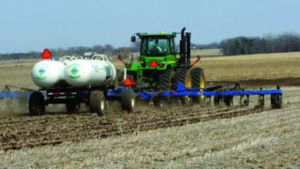 I learned of a farm family in west central Minnesota that spends about $70,000 each year to buy fertilizer for their farm. Corn fertilizer costs have ranged from $120-200 per acre in the last few years so I’m guessing that this family is applying the recommended amount of nitrogen, phosphorus, and potassium to about 400 acres of corn. When their bags are delivered in the early spring, this mortgageable amount of fertilizer fills the entryway of their house.
I learned of a farm family in west central Minnesota that spends about $70,000 each year to buy fertilizer for their farm. Corn fertilizer costs have ranged from $120-200 per acre in the last few years so I’m guessing that this family is applying the recommended amount of nitrogen, phosphorus, and potassium to about 400 acres of corn. When their bags are delivered in the early spring, this mortgageable amount of fertilizer fills the entryway of their house.
I am sure that this farm family does not want to lose one granule of this huge investment. And yet, unknowingly or certainly unintentionally, that is what is happening to a lot of fertilizer that is being applied to farm fields across Minnesota. It is lost.
Fields in the Root River watershed that have been intensively monitored by the Minnesota Department of Agriculture (MDA) for four years lose on average 1.4 lbs of phosphorus per acre (range of <0.1 to 8.3) each year. The phosphorus can dissolve and leave with water, primarily when the ground is frozen in March, or it can move as a particle attached to the sediment, primarily in May and June before the leafy crop canopy protects the soil. This year, look for an earlier dissolved phosphorus spike because of our warm February.
Nitrogen also moves with water — from tile to ditch to rivers, and into groundwater. Annual nitrogen loss in the monitored fields in the Root River ranges from 10 lbs to more than of 34 lbs/acre.
Who loses when fertilizer is lost? All of us: the farm family with the entryway full of fertilizer; neighbors hoping to swim or fish in local lakes that are so fertile that they grow an excess of algae and plants, smothering the aquatic life; small-town residents that have to shoulder the tax burden to build a new water treatment plant so they can drink their groundwater; and taxpayers who fund the monitoring and clean-up of the state’s increasingly polluted waters.

Isn’t it better and cheaper to apply less fertilizer and keep what is applied in place? Yes.
The MDA is the lead state agency for fertilizer management and it is their role to provide guidance so fertilizers do not degrade our water. They have taken initial steps of giving farmers in the most vulnerable areas the opportunity to voluntarily implement best management practices to mitigate the effects of nitrogen pollution. For example, they recommended that these farmers restrict fall and winter application of nitrogen, a time when crops are not growing and using nitrogen. Even commodity groups are stepping up and promoting efficiencies and outreach efforts to reduce nitrogen loss.
It’s a start. If farmers do not voluntarily adopt best management practices, the next steps will be to introduce regulatory action and restrictions. It is our job to make sure farmers and the MDA make adequate and timely progress in achieving their goals.
— Carrie Jennings, research and policy director